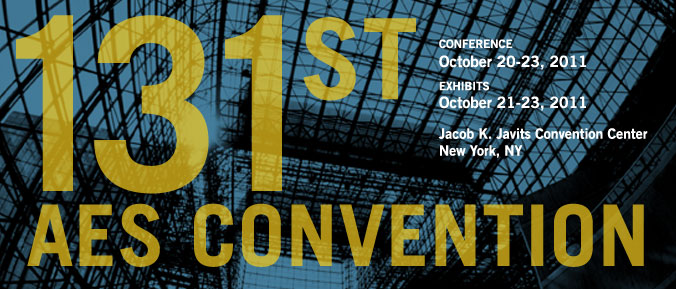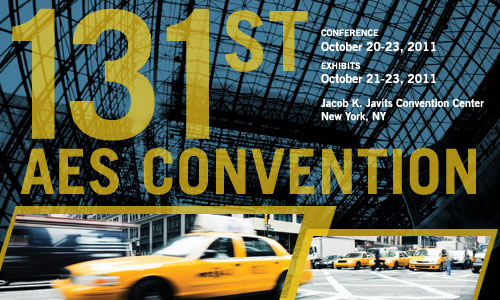
AES New York 2011
Poster Session P21
P21 - Perception
Saturday, October 22, 2:30 pm — 4:00 pm (Room: 1E Foyer)
P21-1 Influence of Different Test Room Environments on IACC as an Objective Measure of Spatial Impression or Spaciousness—Marco Conceição, Trinity College Dublin - Dublin, Ireland, Escola Superior de Musica, Artes e Espectáculo–IPP, Porto, Portugal; Dermot Furlong, Trinity College Dublin - Dublin, Ireland
To investigate the perceptual impression of spaciousness, a physical measure, which relates to listener spaciousness experience, was used. A variable setup was introduced that made possible the control of spaciousness in different rooms. IACC measurements were made using a frontal loudspeaker for the direct sound, with a second loudspeaker for an angled single early reflection positioned in the horizontal plane. Measurements were performed under controlled conditions in which a dummy-head measured Inter Aural Cross Correlation was captured for variable sound fields. It was possible to conclude that there is a similar trend in IACC results from the repetition of the experiments in different rooms. That is, measurement room acoustic details are not crucial to observed trends in IACC variation.
Convention Paper 8555 (Purchase now)
P21-2 The Relationship between Interchannel Time and Level Differences in Vertical Sound Localization and Masking—Hyunkook Lee, University of Huddersfield - Huddersfield, UK
Listening experiments were conducted with a pair of vertically arranged loudspeakers. A group of subjects measured the level of delayed height channel signal at which any subjective effects of the signal became completely inaudible (masked threshold) as well as that at which the perceived sound image was localized fully at the lower loudspeaker (localized threshold), at nine different delay times ranging from 0 to 50 ms. The sound sources were anechoic recordings of bongo and cello performance excerpts. At the delay times up to 5 ms, source type did not have a significant effect for both threshold results and neither threshold varied significantly as the delay time increased. In this time range the average level reduction required for a full image shift was 6~7 dB while that for masking was 9~10dB. At the higher delay times, on the other hand, both thresholds decreased as the delay time increased and the difference between the two sources in both threshold results was significant. Furthermore, the relationship between the two thresholds varied depending on the source type.
Convention Paper 8556 (Purchase now)
P21-3 Observations on Human Sound Source Localization in the Mid-Sagittal Plane and in Anechoic Space—Daniela Toledo, COWI AS - Oslo, Norway
A group of 5 subjects who showed consistently biased sound source localization in the mid-sagittal plane with real sound sources and under anechoic conditions is presented. Three of these subjects were also tested with virtual sound sources synthesized with their own individual head-related transfer functions. Localization under both conditions showed similar trends, even though they could not be considered as equivalent. This suggests that binaural technology was close to emulating the aural experience that the subjects had with real sound sources. These cases are presented to discuss different issues inherent to binaural synthesis, like the way in which the technology is validated and the assumptions that serve as a basis for the technology.
Convention Paper 8557 (Purchase now)
P21-4 Reducing the Cost of Audiovisual Content Classification by Experiment—Ulrich Reiter, Norwegian University of Science and Technology – NTNU - Trondheim, Norway
A set of subjective attributes of audiovisual media content, originally suggested by Woszczyk et al. in a 1995 AES Convention paper was examined for suitability for AV content classification tasks. Subjective experiments indicate that the 4x4 matrix of dimensions and attributes as suggested in the original paper can be reduced to a more compact 3x2 design for classification purposes without loss of information about the perceptual properties of the content. This can significantly reduce the cost of content classification by experiment.
Convention Paper 8558 (Purchase now)
P21-5 Quality and Performance Assessment of Wave Field Synthesis Reproducing Moving Sound Sources—Michele Gasparini, Paolo Peretti, Laura Romoli, Stefania Cecchi, Francesco Piazza, Universita Politecnica delle Marche - Ancona, Italy
Reproduction of moving sound sources by Wave Field Synthesis (WFS) arises some specific problems that make static source approach ineffective. An algorithm for the reduction of artifacts and natural representation of the movement effect, based on the synthesis of two virtual sources moving together, has been proposed in a previous work by the same authors. In this paper a practical implementation of the algorithm is presented and evaluated in terms of workload and subjective sound source localization. The influence of some processing parameters on the computational cost has been studied. The sound quality concerning true spatial reproduction is assessed through listening tests and a comparison with previous approaches is reported.
Convention Paper 8559 (Purchase now)
Information Last Updated: 20111005, mei

